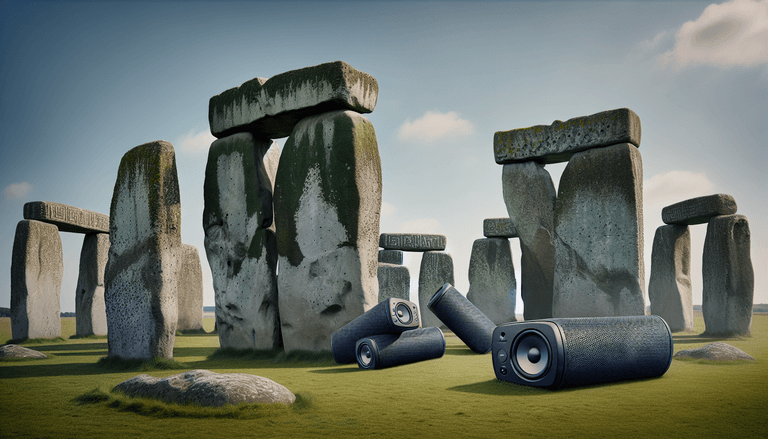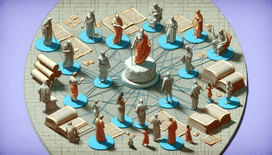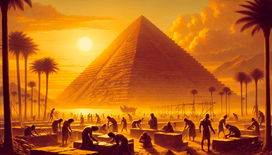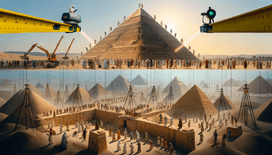Picture, if you will, a foggy Wiltshire morning in 2500 BC. The mist rolls over the Salisbury Plain, casting a mysterious hue over the growing monoliths of Stonehenge. Now, picture a new addition to the ancient landscape: amidst the towering stones sits a gleaming, somewhat anachronistic Bluetooth speaker, blasting tribal chants and Gregorian beats meticulously synchronized with the cosmic rhythms. Welcome to our latest time-hopping escapade where history’s great mysteries meet the convenience of wireless technology.
Rock and Roll… or Just Roll the Rocks?
Stonehenge is a marvel of prehistoric engineering, but its enigmatic purpose has left historians scratching their heads for centuries. Was it a ceremonial site? A primitive form of an astronomical observatory? Or was it just prehistoric Britain’s attempt at hosting Glastonbury? Let’s take it a step further and imagine if the Neolithic architects had a sleek Bluetooth 5.0 speaker to amplify their celestial shindigs with some modern-day bass.
First off, let’s talk logistics. Transporting these hefty sarsen stones wasn’t a walk in the meadow. Rolling logs and sheer human perseverance got the job done, but perhaps the promise of an electrifying disco under the stars would have lubricated the community spirit. Early tribesmen may have lined up ancient Spotify playlists, each titled with primal emojis: 🌞 for the sunrise dance, 🌜 for the moonlit rituals, and a particularly ominous 🪨 for the sacrificial rock anthem. Imagine the thrill of those who dared get jiggy with it under the paleolithic disco lights, or rather, torches, if safety regulations allowed.
Tuning into the Universe
The Stonehenge of our modern imagining becomes more than a site. It’s an experience. Picture druids donning their robes and doling out the Bluetooth codes to all and sundry. An invisible conductor whispers through the air, ensuring the crescendo of each solstice is musically accounted for. The solstices themselves would be influencers of a cosmic symphony, the musik der stein as the sun’s rays and shadowy crescents align to a perfectly timed crescendo on the playlist.
For an extra bit of whimsy, perhaps the builders would dance in circles as they attempted to sync their Bluetooth with the stone ‘enthalith.' Would they argue over who gets to be the DJ this solstice? Ancient squabbles resolved not over who gets the last chunk of woolly mammoth meat, but who chooses the evening’s power ballads. Surely, one tribe would groan as another’s favourite tune remastered by an unexpectedly ahead-of-its-time Algorithm.amoke AI crooned through the stone stereo.
Wireless Wonders of the Ancient World
And what of the surrounding populations? What if the druids had held seminars on the solar-powered speakers for tribes miles around? A revolutionary breakthrough in sound sharing! Penrhyn would’ve boomed with the sounds of prehistorically remastered tunes, a Morse Code of sorts, communicating to distant neighbours that something sacred was afoot. It’s not LTE, but a Neolithic network of treble and drum to shake the very earth (or, at least, cause a bit of a rattle).
Rocking Traditions: To Bluetooth or Not To Bluetooth?
While amusing to ponder, one does wonder how Bluetooth might have altered Stonehenge’s cultural legitimacy. Would songs digitised and disseminated undermine what Neolithic Britons held sacred? Would the melodic hum perhaps be considered more than just accompaniment, but an all-encompassing, cosmic connector that fulfilled Stonehenge's astronomical duties?
Or perhaps Bluetooth earbuds would become the arch-rival of the revered Elders imploring the crowd to listen, not just hear. Those impromptu rave reviews might not have always been kind:
- ‘Stonehenge speaker selection? Absolute rot.’ – Ancient Audible Review, 2/5 stars.
- ‘The bassline at sunrise, bloody marvellous!’ – Neolithic News Weekly.
While wholly impractical (and a logistical nightmare), imagining Bluetooth speakers at Stonehenge is a fun romp through our most human of endeavours: creating and connecting through whatever tools we have at hand. Tender hope that whether rocks or rhythms, humanity has always sought ways to shake, rattle, and roll through history’s merry dance.
So, next time you see Stonehenge, imagine a time when druids might have cranked up the volume, sharing heartbeat tempos with the universe, a timeless tune resonating through the annals of time. Who knows? The original builder might just have been history’s very first DJ manager, orchestrating a gig that spanned millennia.







